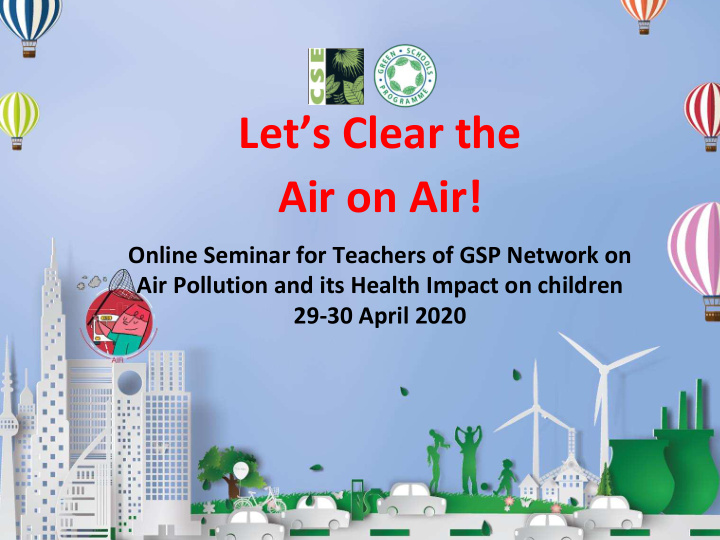



Let’s Clear the Air on Air! Online Seminar for Teachers of GSP Network on Air Pollution and its Health Impact on children 29-30 April 2020
Announcements Gobar Times is now online! Go to downtoearth.org.in You can submit essays on topics such as food, water, waste, pollution, forests and so on to editor@gobartimes.org You can also share fictional write-ups like poems and short stories, related to the above topics The word limit is 650-700 words for stories, essays, etc If you are sharing images, please share high resolution (2 MB and above )pictures with brief captions If images are related to an event, make sure you share details like the names of those in the picture, date and venue of the event, designation (in case of teachers and officials) and class (in case of students). Avoid summary of events held in the school. Instead, you can share your individual learnings from the event We encourage our friends to write about their experiences. For example, how have you experienced air pollution and how has it impacted you? Or you can write about one regional dish that is prepared in your house and what is the story behind it. Do share the recipe too! GSP Online courses Activity Handbook
Lesson Learnt? ….this is not the way we want to clean our air or our water ― however desperately we need this to happen……we did, momentarily, get this sense and smell of what clean air, clean rivers and exuberant nature means. And we must value it. We must remember this time as the way we want it to be, when our lungs can inhale and exhale without the stress of toxins.
Climate Crisis • Cannot lose sight of the bigger issue • Our actions have major consequences • Cannot afford to unlearn • What can be done? – Underscores the need for Environment Education
GSP Audit 2019: Air Findings • Of the 1704 schools that submitted the audit, 79 per cent schools do not own or use vehicles. • In 41 per cent schools, more than half of the population uses sustainable motorised vehicles • In 44 per cent schools, more than half of the population uses non-polluting transport • 24 per cent schools only use SMV and NPT • 18 per cent schools burn waste
GSP Audit in the Classroom
Indoor Air Pollution • Indoor air pollution (IAP) is as harmful as ambient air pollution… and maybe more in some cases • In a year, 2.6 million premature deaths are caused by IAP. • Inefficient burning of fuels like firewood is one of the prime reasons, but there are many more!
Indoor Air Pollution What’s hiding in our homes? Source: i.pinimg.com
Indoor Air Pollution: Steps to Follow • Identify the sources of indoor air pollution in each numbered area of the house • List the areas point wise along with the pollutants present (in points) Example: 3. Bathroom: Aerosol spray (deodorants) • Share your responses by 11 AM, 30 April 2020 on support@greenschoolsprogramme.org
Indoor Air Pollution: Sources 1. Storeroom/Attic: VOCs (volatile organic compounds/gases) from paints, mold, dust; biological pollutants (mites, dust, bacteria) 2. Bedroom: VOCs from furniture; mattress dust; aerosols in insect repellents; asbestos and formaldehyde in building material 3. Bathroom: Bacteria and mold from humidity; VOCs from cleaning products; aerosol sprays; water leakages
Indoor Air Pollution: Sources 4. Kitchen: Particulate matter (PM) from stoves and chimneys; VOCs from disinfectants; burning of fuels; gas emissions like CO, CO 2 , formaldehyde 5. Living Room: Carpet and curtain dust; emissions from paint and furniture; fireplace emissions; tobacco smoke; VOCs like acetone, benzene, formaldehyde from air fresheners; biological pollutants; cooling/heating system
What can we do about IAP? • Maintaining proper ventilation inside the house • Indoor air plants like money plant, snake plant, aloe vera, areca palm • Use of cleaner fuels • Hygiene: Keeping cleaning products tightly packed; manage waste properly and covering waste • Regularly assessing water and gas leakages
Environmental Education: IAP • Linking textbook content to real-life experiences: A lesson on particulate matter for Grade 6 can be linked with sources of it outdoors and indoors • Encouraging region-specific ways to curb air pollution • Home-made sensors and air purifiers as projects
In-House Air Purifier - An air purifier made by DRV DAV Centenary Public School, Phillaur, Punjab - Made from waste car air filter mould, electric fan and filter paper
Quiz based on Down to Earth Video Stopmotion: Use and Regulation of Diesel Vehicles Leaderboard
Quiz based on the presentation on Mobility Practices and Trends Leaderboard
GSP Performance Report 2019 Key points • Based on the data submitted by schools • Includes feedback and recommendations on crucial points • Gives direction to schools to be green and improve the practices in the next year • Simple structure
For schools in GSP network DOWNLOAD REPORTS AND CERTIFICATES • School Dashboard • Downloads • Response Report • Performance Report • Digital Certificate for staff and students
GSP Snapshot – Category wise Category 2015 2016 2017 2018 2019 Green (70% and 105 71 54 118 182 above) Yellow (50%-69.9%) 92 208 357 535 685 Orange (35%-49.9%) 223 352 640 818 856 Red (below 34.9%) 106 69 142 218 275 Total submissions 526 700 1193 1689 1998 https://www.greenschoolsprogramme.org/schools/gsp-audit/green-schools-awards/gsp-award-2019-20/is-your-school-green/
Section wise
Air • Window-to-floor ratio • Vehicle ownership • Vehicle health • Fuel use • Commuting practices
Energy • Energy Consumption • Sources of Energy • Use of renewable sources of energy
Food • Mid-day meals or Lunch from home • Kind of food served/sold in school • Distribution of packaged foods
Land • Land-use – Green cover • Biodiversity • Use of pesticides
Water • Per day per capita consumption • Sources of water • Water conservation – RWH – Wastewater recycling • Sanitation
Waste • Segregation of waste • Waste collection and generation • Waste recycling and disposal
THANK YOU! For any queries, please write to support@greenschoolsprogramme.org
Recommend
More recommend